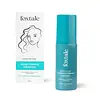What's inside
What's inside
 Key Ingredients
Key Ingredients

 Benefits
Benefits

 Concerns
Concerns

 Ingredients Side-by-side
Ingredients Side-by-side

Water
Skin ConditioningCocamidopropyl Hydroxysultaine
CleansingSodium Methyl Cocoyl Taurate
CleansingPropanediol
SolventPEG-7 Glyceryl Cocoate
EmulsifyingCoco-Glucoside
CleansingGlyceryl Oleate
EmollientCocamide DEA
EmulsifyingSalicylic Acid
MaskingBetaine
HumectantSodium Cocoyl Isethionate
CleansingDisodium Cocoyl Glutamate
CleansingSodium Citrate
BufferingNiacinamide
SmoothingBisabolol
MaskingSodium Hyaluronate Crosspolymer
HumectantPhenoxyethanol
PreservativeEthylhexylglycerin
Skin ConditioningCitric Acid
BufferingSodium Hydroxide
BufferingParfum
MaskingWater, Cocamidopropyl Hydroxysultaine, Sodium Methyl Cocoyl Taurate, Propanediol, PEG-7 Glyceryl Cocoate, Coco-Glucoside, Glyceryl Oleate, Cocamide DEA, Salicylic Acid, Betaine, Sodium Cocoyl Isethionate, Disodium Cocoyl Glutamate, Sodium Citrate, Niacinamide, Bisabolol, Sodium Hyaluronate Crosspolymer, Phenoxyethanol, Ethylhexylglycerin, Citric Acid, Sodium Hydroxide, Parfum
Water
Skin ConditioningCocamidopropyl Betaine
CleansingGlycerin
HumectantCaprylyl/Capryl Glucoside
CleansingSodium Methyl Cocoyl Taurate
CleansingDisodium Cocoyl Glutamate
Cleansing3-O-Ethyl Ascorbic Acid
Skin ConditioningSodium Ascorbyl Phosphate
AntioxidantSilanetriol
Hyaluronic Acid
HumectantPanthenol
Skin ConditioningCitrus Sinensis Fruit Extract
AntioxidantCarica Papaya Fruit Extract
Skin ConditioningTerminalia Ferdinandiana Fruit Extract
AntioxidantCitric Acid
BufferingBHT
AntioxidantDisodium EDTA
Benzyl Alcohol
PerfumingEthylhexylglycerin
Skin ConditioningTocopherol
AntioxidantCI 15985
Cosmetic ColorantCI 45100
Cosmetic ColorantWater, Cocamidopropyl Betaine, Glycerin, Caprylyl/Capryl Glucoside, Sodium Methyl Cocoyl Taurate, Disodium Cocoyl Glutamate, 3-O-Ethyl Ascorbic Acid, Sodium Ascorbyl Phosphate, Silanetriol, Hyaluronic Acid, Panthenol, Citrus Sinensis Fruit Extract, Carica Papaya Fruit Extract, Terminalia Ferdinandiana Fruit Extract, Citric Acid, BHT, Disodium EDTA, Benzyl Alcohol, Ethylhexylglycerin, Tocopherol, CI 15985, CI 45100
Ingredients Explained
These ingredients are found in both products.
Ingredients higher up in an ingredient list are typically present in a larger amount.
Citric Acid is an alpha hydroxy acid (AHA) naturally found in citrus fruits like oranges, lemons, and limes.
Like other AHAs, citric acid can exfoliate skin by breaking down the bonds that hold dead skin cells together. This helps reveal smoother and brighter skin underneath.
However, this exfoliating effect only happens at high concentrations (20%) which can be hard to find in cosmetic products.
Due to this, citric acid is usually included in small amounts as a pH adjuster. This helps keep products slightly more acidic and compatible with skin's natural pH.
In skincare formulas, citric acid can:
While it can provide some skin benefits, research shows lactic acid and glycolic acid are generally more effective and less irritating exfoliants.
Most citric acid used in skincare today is made by fermenting sugars (usually from molasses). This synthetic version is identical to the natural citrus form but easier to stabilize and use in formulations.
Read more about some other popular AHA's here:
Learn more about Citric AcidWe don't have a description for Disodium Cocoyl Glutamate yet.
Ethylhexylglycerin (we can't pronounce this either) is commonly used as a preservative and skin softener. It is derived from glyceryl.
You might see Ethylhexylglycerin often paired with other preservatives such as phenoxyethanol. Ethylhexylglycerin has been found to increase the effectiveness of these other preservatives.
This gentle cleansing and foaming ingredient is known for leaving a smooth feeling in skin and hair. It is made using coconut oil.
According to the manufacturer, it is soluble in water and has resistance to hard water, acid, and alkali.
Due to its coconut base, it may not be Malassezia folliculitis safe.
Learn more about Sodium Methyl Cocoyl TaurateWater. It's the most common cosmetic ingredient of all. You'll usually see it at the top of ingredient lists, meaning that it makes up the largest part of the product.
So why is it so popular? Water most often acts as a solvent - this means that it helps dissolve other ingredients into the formulation.
You'll also recognize water as that liquid we all need to stay alive. If you see this, drink a glass of water. Stay hydrated!
Learn more about Water